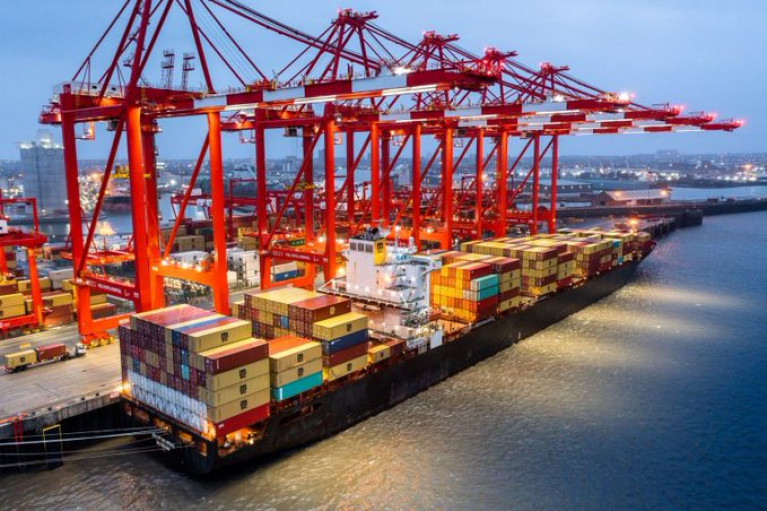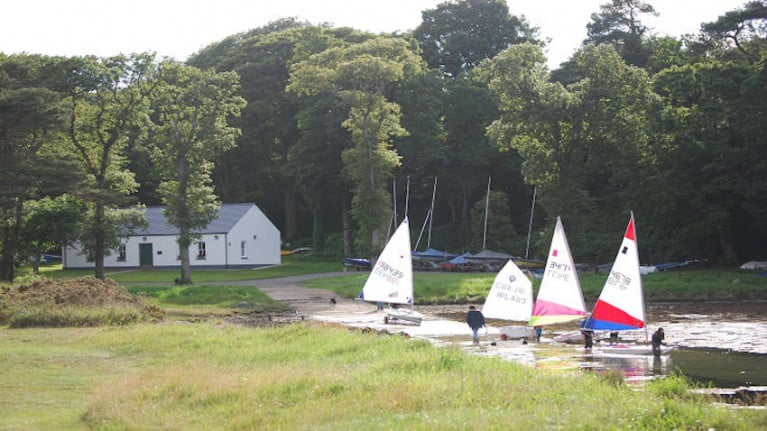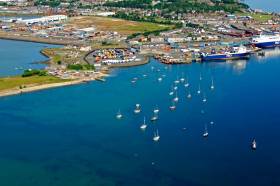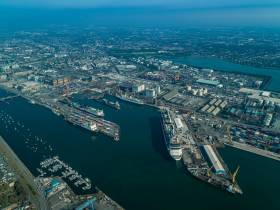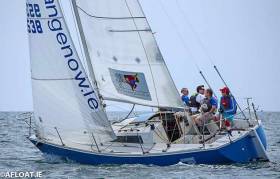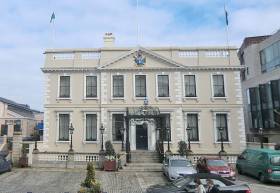Displaying items by tag: Awards
The Northern Ireland sailing community enjoyed a celebratory evening at Riddel Hall in Belfast last Friday (19 April) as people came together for the RYA Northern Ireland Annual Awards.
The evening was “the perfect opportunity to recognise the achievements of everyone involved in Northern Irish sailing, from a grassroots level of volunteering, to elite performance level sailors who have been successful on the world stage”, RYANI said.
The awards, which are nominated by RYANI members, also took place one year on from the launch of RYANI’s five-year strategy, Navigating The Future, “and it was fantastic to see how sailing has developed in Northern Ireland over the last 12 months”.
Speaking on the evening, RYANI vice-chair Gavin Watson said: “We all think of the RYA supporting performance sailors — the RYA is much more than just performance. It’s all about the environment, the older generations that go cruising and the clubs that want to create sailing for their members that are in the community.”
Nominations Now Open for RYA Northern Ireland’s 2023 End-of-Season Awards
As RYA Northern Ireland marks its 50th anniversary and reflects on a fantastic year for sailing and boating in Northern Ireland, it’s time to submit nominations for its end-of-season awards and celebrate the best of the region in 2023.
The award ceremony will take place on Friday 19 April 2024 at Queen’s University Belfast’s Riddle Hall.
Alongside the regular categories of Race Coach, Race Official, Volunteer, Young Powerboater, Young Volunteer, Instructor and Young Sailor of the Year, as well as the RYANI Chair’s Nomination, this year there is the new category of Club Project of the Year, which replaces Club of the Year to align more closely with RYANI’s five-year strategy Navigating the Future.
The closing date for nominations on Wednesday 31 January 2024. For the different awards criteria and how to submit your nomination, visit the RYA website HERE.
Mersey Maritime Awards Celebrate Liverpool City Region Sectors of Industry Excellence
Mersey Maritime's 9th Annual Industry Awards were hosted at the iconic Liverpool Cathedral, marking a significant highlight in the UK maritime sector’s calendar.
More than over 550 distinguished guests (YouTube highlights) on 2nd November from across the United Kingdom and beyond to come together to recognise outstanding achievements and innovations in the maritime industry.
The awards process received an overwhelming response, with more than 100 individual applications submitted on behalf of over 50 diverse businesses and organisations. These submissions represented various sectors within the maritime industry, underscoring the broad spectrum of talent and expertise in the field. The rigorous judging process, which included expert assessment and an industry-wide vote, saw a record-breaking 2,500 votes cast, showcasing the sector’s deep interest in and commitment to the awards.
This year, Sam Quek MBE, Olympic gold medallist and TV presenter, assumed the role of host for the evening. Born and raised in the North West, Sam brought a deep connection to the region, adding a personal touch to the event.
A key highlight of the evening was the keynote address delivered by Katherine Fairclough, CEO of Liverpool City Region Combined Authority. In her address, Katherine, emphasised the pivotal role of the maritime industry in driving growth and investment within the Liverpool City Region. Her insights and vision for the future underscored the critical importance of the sector in the region’s economic development and global standing.
The prestigious Business of the Year Award was presented to Stone Marine Shipcare Ltd, an exemplary company renowned for its dedication and excellence in the maritime sector. Stone Marine Shipcare Ltd was founded in 1946 and has a rich history of providing comprehensive marine services in the Liverpool City Region and beyond.
The highly sought-after Maritime Ambassador Award was awarded to Sir Michael Bibby, a distinguished figure known for his outstanding contribution to the maritime industry over the course of his career. Sir Michael has been a prominent and influential leader in the sector, serving as the former CEO of the Bibby Line Group, a renowned shipping and logistics company; one of the oldest family maritime companies in the region. His visionary leadership and advocacy for the maritime industry have left a lasting mark on it and this award was clear recognition of that fact.
Diamond sponsors for the event were Kays Medical, Liverpool John Moores University, and Peel Ports Group, alongside other category sponsors. The awards celebrated the best-in-class within the maritime sector and highlighted the Liverpool City Region’s commitment to driving growth and investment.
As part of the proceedings, those attending were invited to support Mersey Maritime’s chosen charity for 2023, The Hive, which is based in Wirral. The Hive Youth Zone in Birkenhead is a state-of-the-art purpose-built centre for young people within our area, where 1 in 3 children live in poverty. The Hive exists to help young people feel happy, healthy and to thrive within their community. Always putting young people first, they combine high quality youth work with inspiring activities in an inclusive, safe space. We are delighted to announce that an astonishing £33,000 was raised on the night to support the vitally important work of this exceptional local charity. We pay tribute to all those who were so generous in responding to this call to action – thank you!
Ruth Wood, CEO at Mersey Maritime, commented on the event, stating: “These awards are a testament to the exceptional standards and world-class expertise on display within the Liverpool City Region’s maritime community. The sector contributes over £5 billion to the region’s economy, supporting over 45,000 jobs. Mersey Maritime was established to create an ecosystem that champions one of the most diverse maritime regions globally. We are honoured to have played a role in fostering a thriving and internationally significant maritime cluster, built on collaboration and excellence. Our commitment remains unchanged: to support job creation and champion industry growth. We were delighted once again to recognise so much success in our region over the last year with yet another successful Mersey Maritime Industry Awards.”
Katherine Fairclough, CEO of Liverpool City Region Combined Authority said: “The Maritime Sector has always been a vital part of our city region’s economy and we have led the way ever since the world’s first commercial wet dock opened here in 1715. The excellence on show at these awards clearly demonstrates that leading role continuing today.
“Through exciting developments including the Liverpool City Region Freeport and the Mersey Tidal Power project, the Combined Authority, led by Mayor Steve Rotheram and our six Local Council Leaders, is working to ensure that proud history of entrepreneurship and innovation contributes to a bright future for our whole city region.”
Maritime Minister Baroness Vere said: “For over two decades, Mersey Maritime has championed the world-class businesses and organisations across the North West’s thriving maritime sector, and I’d like to congratulate the worthy nominees and winners for their success at this year’s awards event.
“Liverpool has a strong and historic maritime past but it’s also fantastic to see industry’s commitment to the sector’s future, reflecting the shared goal of both industry and government to boost UK wide trade, decarbonise, and improve the air quality in our coastal communities as we build a greener, cleaner maritime industry.”
The full list of Mersey Maritime Industry Awards winners is as follows:
Business of the Year, sponsored by Maersk: Stone Marine Shipcare Ltd
Diversity Champion Award, sponsored by Peel Ports Group: Maersk
Commitment to Maritime in LCR Award: Brian Melia – Cruise Liverpool
Employer of the Year, sponsored by Kays Medical: National Oceanography Centre
Future Skills Award, sponsored by Nautilus International: Cammell Laird Shiprepairers & Shipbuilders Ltd
International Trade Award, sponsored by Brookes Bell: Royal HaskoningDHV
Maritime Professional Services Award, sponsored by BAE Systems: Hill Dickinson LLP
Net Zero Award, sponsored by Liverpool John Moores University: Svitzer
Positive Impact Award, sponsored by Cammell Laird: Battle of the Atlantic Memorial
Rising Star Award, sponsored by Royal Navy: Leah Rogers – Thetius
SME of The Year, sponsored by Denholm Logistics: The SeaKing Group
Technology & Innovation Award, sponsored by MTC: Brookes Bell
To view all wTo view all winners, click here.
Global Maritime Search and Rescue (SAR) Community Urged to Highlight Operational Excellence
Nominations for this year's International Maritime Rescue Federation (IMRF) annual awards have opened, which looks to recognise volunteer and professional maritime search and rescue (SAR) personnel from around the world.
This year’s awards, which will be the eighth to take place, will also focus on those who have dedicated their lives to developing maritime SAR services, as well as those developing innovative technology and equipment, and those encouraging more women to enter a traditionally male-dominated sector.
“Every day, maritime SAR volunteers and professionals do everything they can do to help those in distress at sea, but we should not take their work for granted.
The IMRF Awards are our way of highlighting the incredible work done by men and women, 365 days a year, to keep us all safe at sea, as well as showcasing new equipment and technologies that are making SAR operations more effective,” says Caroline Jupe, Chief Executive Officer of the IMRF.
“The entire global maritime SAR community continues to innovate to tackle complex operational challenges, particularly as issues surrounding climate change and the climate transition will have a major impact on maritime industries and communities. The IMRF Awards are our way of giving back to those looking to safeguard our future,” she adds.
This year’s awards will have five categories that are open for nominations:
⦁ Individual: For Outstanding Individual Contribution to Maritime SAR Operations
⦁ Team: For Outstanding Team Contribution to Maritime SAR Operations#
⦁ Innovation & Technology: For Innovation and Technology in the field of Maritime SAR
⦁ Vladimir Maksimov Award for Lifetime Achievement: For Lifetime Achievement in the Maritime SAR Sector. This award is sponsored by Inmarsat, the world leader in global mobile satellite communications, providing safety communications at sea since its inception by the International Maritime Organization in 1979 (www.inmarsat.com).
⦁ #WomeninSAR Award: For an individual, who has made an outstanding contribution to improving equality of opportunity for women and girls in Maritime SAR. This award is sponsored by HamiltonJet, the developer of waterjet and control systems that deliver manoeuvrable, reliable and safe propulsion for SAR vessels (www.hamiltonjet.com).
The closing date for nominations is 31 July 2023 and the shortlist will be announced on 29 September 2023. The winners will be announced on 18 October 2023.
Nominations can be submitted online here:
Across the Irish Sea is where Mersey Maritime has launched their eighth annual industry awards and is calling for maritime and logistics businesses throughout the Merseyside region and the greater North West of England to start preparing their entries for 2022.
The UK’s leading maritime awards ceremony celebrates the achievements of the industry’s most outstanding companies and individuals. Applications are encouraged from any maritime or maritime related organisation, business and/or individual that operate in, or support, the North West region.
This year the MMIA’s theme will be ‘Our Time is Now’ which will have a particular focus on Mersey Maritime’s 20-year anniversary and look forward to the bright future of the sector. Mersey Maritime was conceived to create an ecosystem, championing and supporting one of the most diverse maritime regions in the UK and has been doing so ever since its founding in 2002.
Awards ceremony
The awards will take place on Thursday 10 November 2022, in the prestigious location of Liverpool’s iconic Anglican Cathedral. It is expected that 2022 will be the biggest yet with more than 600 industry professionals likely to be in attendance.
Application process
Entries for the Mersey Maritime Industry Awards 2022 will open later in the week, and can be submitted via the Mersey Maritime website (here). There are 14 award categories in total which can also be consulted on the website.
The closing date for submitting award entries is Monday 5th September 2022.
Every application received is assessed by Mersey Maritime’s industry judging panel who select the finalists for each category following a vigorous process. The winner of each category will once again be determined by the industry itself, with an industry voting platform launching in early October 2022.
To view the award categories, apply for an award or buy tickets/tables, please visit Mersey Maritime’s website
Strangford Sailing Club Selected as Finalist for RYA/Yachts & Yachting Club of the Year 2021
Strangford Sailing Club has been named among the finalists for RYA and Yachts & Yachting Club of the Year 2021.
Ten clubs across the UK have been selected by the RYA Awards Panel, with online voting now open.
The Co Down club is the only Northern Ireland finalist this year for the annual gong, which saw Strangford Lough Yacht Club and East Antrim Boat Club in the running this time last year.
The RYA and Yachts & Yachting Club of the Year award, supported by Gallagher, recognises the outstanding achievement of sailing clubs across the UK and promotes the hard work and dedication that goes into running a successful club.
Voting closes on Monday 25 January, and the award presentations and overall winner announcement will be made at the RYA Virtual Dinghy Show on 27-28 February.
Two NI Clubs Make Final List For RYA/Yachts & Yachting Club Of The Year 2020
Strangford Lough Yacht Club and East Antrim Boat Club in Northern Ireland have been named among the 10 finalists selected for the RYA and Yachts & Yachting Club of the Year Award for 2020.
East Antrim Boat Club is also among five of the finalists recognised for particular achievements, with the Larne Lough club acknowledged for ‘Embracing Modern Communications’.
The annual RYA and Yachts & Yachting Club of the Year Award, supported by Gallagher, recognises the outstanding achievement of sailing clubs across the UK and promotes the hard work and dedication that goes into running a successful club.
Voting opens on Friday 13 December, and the award presentations and overall winner announcement will be made at the RYA Dinghy Show 2020 on Saturday 29 February.
Engineering Projects in Dublin Port Among Award Shortlist: Public Invited to Cast Vote
Two projects in Dublin Port have been shortlisted for the 'Engineering Project of the Year' and both are located within Alexander Basin which is undergoing a major redevelopment as part of the port's Masterplan 2040.
The port projects shortlisted are Ocean Pier Berth 31-34 (see: another 'Brexit-Buster) located to the east of Alexandra Basin and a new Ro-Ro Jetty. The latter is sited on the opposite west side of the basin nearby to the Tom Clark Toll-Lift Bridge, otherwise widely known as the East-Link.
Construction of these particular projects within the Alexandra Basin Redevelopment (ABR) works were carried out by Keating as part of the Roadbridge Keating Joint Venture which has been shortlisted at the Engineers Ireland Excellence Awards 2019.
The Awards recognises the highest level of achievement in the engineering field and provides peer recognition of outstanding Irish engineering work.
Engineers Ireland is calling on the Irish public to vote online for what they consider to be the Engineering Project of the Year. To take part, voting must be cast before the deadline of (tomorrow) midnight, Friday, November 8, 2019. To find out more about casting your vote click this link.
Royal St George Oscars Nominees Revealed For 2019
The Royal St George Yacht Club has revealed the nominees for its Annual Sailing Awards, otherwise known as the RStGYC Oscars.
Chris Power Smith’s J/122 Aurelia is guaranteed a share in the Commodore’s Cup for best offshore performance as the nominees comprise Team Joshua Trio (Aurelia, Platinum Blonde and Windjammer) and his own campaign.
Keelboats and crew in the running for the Enriquetta Cup this year are Brendan and Sarah Foley and their Impala Running Wild (pictured top), Michael O’Connor’s SB20 Sin Bin, and Richard and Philip Lovegrove with their Sigma 33 Rupert.
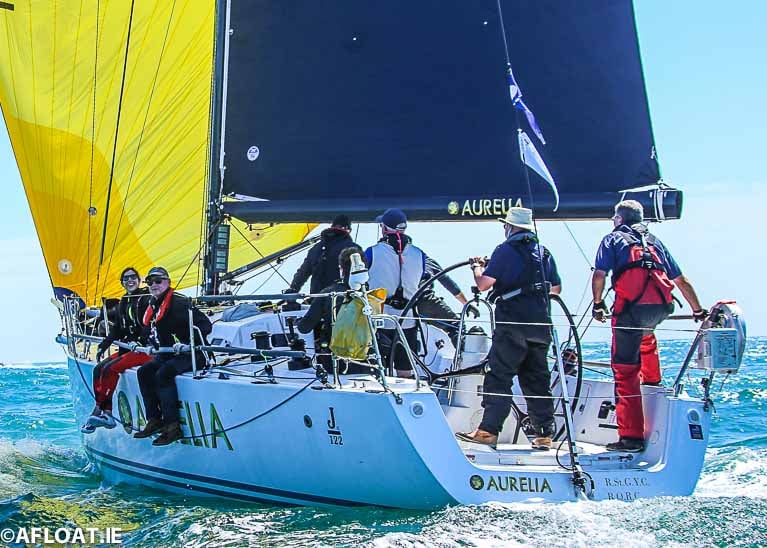 Chris Power Smith’s J/122 Aurelia
Chris Power Smith’s J/122 Aurelia
Significant dinghy performance is rewarded with the Vice-Commodore’s Cup, whose nominees include promising Optimist talent Charlie Cullen and Laser sailors Jack Fahy, Tom Higgins and Shirley Gilmore.
Gilmore is also nominated for the Causeway Trophy for sportsmanship alongside Harriet Walker, Ross O’Leary and Emily Riordan.
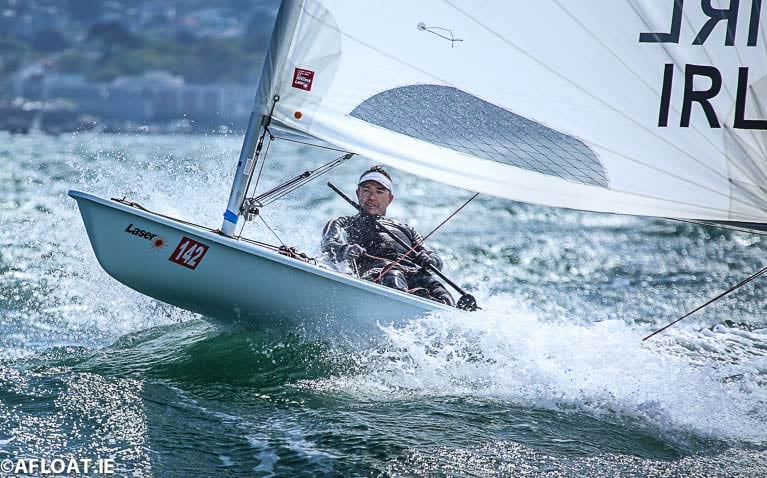 Ross O'Leary
Ross O'Leary
Optimist sailor Riordan shows up again in the shortlist for the Youth Award, with Laser 4.7/Waszp sailor Alana Coakley, 420 pair Grace O’Beirne and Kathy Kelly, RS Feva duo Elysia O’Leary and Lily Dwyer, and former Oppy and now Laser competitor Moss Simington.
Ross O’Leary, meanwhile, is also in the running for the Waterfront Award for significant contribution to the sport of sailing.
His excellent work as Laser class captain is recognised along with Laser Masters Worlds committee chair David Kelly, rowing fitness instructor John Sheehy, and Irish Sailing Pathway Nationals chair Ian Simington.
And rounding out the awards, Paul Conway’s Cervantes and Birmayne (Justin McKenna, Paul Dobbyn and Crew) are up for the O’Hanlon Cup for best cruise of 2018.
The RStGYC Oscars will be awarded on Friday night 6 April at a black tie gala dinner in the clubhouse from 6.30pm. Members can book their places HERE.
Sail Training Ireland Awards & Season Launch This Saturday
Sail Training Ireland will hold its seventh annual prize-giving and season launch event this Saturday 2 February at the Mansion House in Dublin, courtesy of Lord Mayor of Dublin Nial Ring.
The event will see awards being presented to trainees who made an outstanding contribution to their individual voyages and to the charity in 2018.
Sail Training Ireland helps young people from all backgrounds and abilities to participate on training and self-development programmes on tall ships.
The organisation is the beneficiary of new State funding to the tune of €85,000 for young people with disabilities and from disadvantaged backgrounds to embark on tall ship training voyages.
Sail Training Ireland chief executive Daragh Sheridan hailed the announcement as “a hugely positive development” that would enable the charity “to offer the life-changing opportunity of sail training voyages to even more young people across the island of Ireland”.


























